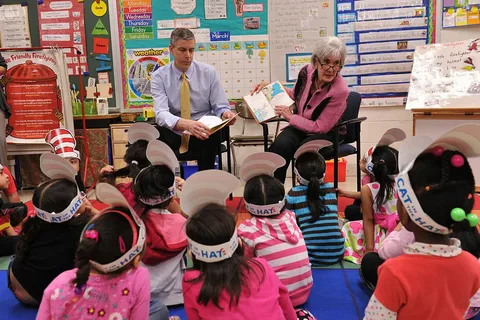What’s new in the U.S. Department of Education?
Outline:
- Introduction
- The reason why this U.S. Department of Education is important to all of us
- A brief overview of what they do and why you should be concerned
- What Is the U.S. Department of Education?
- Their primary goals
- They play a crucial role in the field of education
- What impact do they have on students, schools, and teachers?
- Latest U.S. Department of Education Updates
- Student loans and programs for debt relief
- More money in Title I schools
- Digital learning is a must
- Changes in the cost of college and community college help
- How These Changes Impact You
- For parents and students
- For teachers and schools.
- Future workforce
- Breaking Down Key Program Changes
- Information on changes to student loans
- Improvements in K-12 education
- Skills-based and higher education
- FAQs on the U.S. Department of Education
- Addressing common questions
- Conclusion
- Last thoughts on staying up-to-date and maximizing new opportunities

Introduction
If you’re like the majority of people, news about education may seem “in the background,” but it’s really worth keeping an eye on.
The U.S. Department of Education has a huge impact on everything from the costs of college to the quality of local schools to what kind of jobs youngsters will get after the completion of their studies.
Being aware of what’s happening at this Department of Education can help to make better choices, whether an educator, a parent, or someone else keeping an eye on the future.
What Does the U.S. Department of Education Do?
What Is It, and Why Should You Care?
The U.S. Department of Education (or “ED”) is the government agency responsible for overseeing the education system across America.
While they’re not directly in charge of your school, they set the policies that govern funding, set policies, and carry out much research to help support education. Their mission is to warrant that every student succeed. This means they concentrate on topics like secure schools and equality in access to education in addition to fair financing.
Key Roles of the Department of Education
- Funding for Schools and Programs
They pay for public schools, offer grants and provide scholarships to college students. - Setting Education Policies
They establish guidelines that aid institutions in increasing the quality of their education and warranting the safety of students. These policies cover many aspects, including testing requirements and safety on campus. - Research and Innovation
ED invests in research to discover better and more innovative methods of teaching. This includes things like online learning as well as better training for teachers as well as ensuring that all students receive a top-quality education.
In executing these three major tasks by assuming these three main roles, the Department of Education supports both educators and students across the country.
Latest U.S. Department of Education Updates
Let’s discuss the latest developments. Here are a few major changes:
1. Changes to Student Loans and Debt Relief Programs
Student loans pose a big problem for a lot of Americans. This is what Department of Education is doing: Department has been doing to address the issue:
- More Flexible Repayment Options
They’re focused on income-driven repayment plans, which means the amount of repayment is dependent on the amount individuals earn, not the amount they have to pay. - Expanded Forgiveness Programs
Public service jobs such as nursing or teaching are now eligible to be eligible for loan repayment. The aim is to reduce the burden on those who are active in their communities.
2. More Funding for Title I Schools
Title I schools serve students from low-income communities. The ED is increasing money to help these schools reduce their “achievement gap,” which is the performance gap between students of low income and their peers.
What is the significance of it?
With more funds, schools can serve more resources to students who are most in need, such as tutoring for extra students or counseling programs.
3. Push for Digital Learning
Following the pandemics, digital learning has become a necessity. The ED invests more in technology and online resources so that each student can access quality digital learning.
What does this mean for students?
More online learning options, improved availability of digital tools, as well as support educators to boost the digital teaching abilities.
4. College Affordability and Support for Community Colleges
The cost of college is the biggest stressor for many families. The Department is attempting to make it easier for families to pay for the cost of higher education.
Here’s how:
- Holding Colleges Accountable
Colleges are being pushed to make it clear about their costs and outcomes to assure that students are aware of the exact amount they’re paying. - Investing in Community Colleges
Community colleges are affordable ways to gain job skills The ED is determined to make these options more affordable.
How These Changes Impact You

You may be a student, an educator, parent or simply love education; these updates can alter your daily life.
For Students and Parents
- Lower Debt Stress
Flexible repayment plans means you don’t have to doubt about student debt. - More Resources in Schools
More funding for schools in low-income regions could result in more support, safer schools and a greater number of education tools. - Better Digital Learning
The improved accessibility to online resources helps students to learn and keep up at their own speed.
For Teachers and Schools
- More Funding and Resources
With the rise in Title I funding, teachers are likely to receive more help in schools with lower incomes. - Training for Digital Education
Teachers are getting methods of training and tools for adapting in online education, and this help them communicate with their students in a virtual world. - Clearer Standards and Goals
New accountability standards are an increased emphasis on quality education.
For the Future Workforce
Policies on education directly impact the abilities of the future workforce.
The ED supports talent training as well as community colleges and technical programs that assist students in learning practical talent, which leads to secure job opportunities that pay well.
Breaking Down Key Program Changes
1. Student Loan Changes and Relief Programs
The ED has released major revisions to student loan forgiveness and repayment.
- Income-Driven Repayment Plans
The payment system is now determined by income, meaning you won’t be stuck with the burden of a monthly payment that’s difficult to manage. - Expanded Loan Forgiveness
Public service employees in positions, such as nurses, teachers, and government employees, may be eligible for the forgiveness of loans after a certain time period.
The bottom line is that these changes result in less stress over debt and more focus on careers that support communities.
2. K-12 Education and Title I Support
With the new funding available in Title I schools, the Department hopes to reduce the “achievement gap” and support students who require extra assistance.
This includes:
- After-school programs
- Additional resources for mental health
- Teachers will have better resources to use in areas of high-need
3. Higher Education and Community College Support
The ED is dedicated to making college cost-effective and pertinent to the current job market.
- More Investment in Community Colleges
The colleges provide an affordable education as well as job-training The Department will warrant that more students have access to these opportunities. - Skills Training Programs
The programs that teach job skills skills specifically in areas such as healthcare and technology are receiving more money.
The goal is to focus on providing affordable, effective education options for all.

FAQs About U.S. Department of Education News
What’s going on with student loan forgiveness?
There are new programs that make loans repaid for those working in public service positions, including teachers, government employees, and healthcare professionals. The goal is to assist people who support their communities.
What is the process by which the Department of Education decides where to allocate funds?
Most funding goes to programs and schools that require it the most, particularly Title I schools in low-income areas, universities that provide students with low numbers, as well as programs that offer additional crucial knowledge.
What is the reason there is a demand for online learning?
The pandemic proved the importance of digital access. The ED is adamant that all students have access to high-quality online sources, regardless of their income or where they live.
What are the implications of these policies for me, even if I’m not a student?
Policies governing education impact taxes, local resources, and the talent of the future workforce. Even if you’re not directly involved in the changes, they can affect the economy of your area and communities.
What is the Department of Education doing about the rising cost of college?
They’re demanding colleges pay for their expenses and putting money on community colleges to provide low-cost alternatives.
Is Title I funding suitable to assist schools with low incomes?
The increase in Title I funding is a beginning. It will impart additional resources, but there is still a lot to be done to eliminate this achievement gap.
Conclusion
The U.S. Department of Education is making major adjustments to warrant that teachers, students, and their communities thrive.
From alleviating the burden of student loans to improving education for K-12 students in order to make college affordable, changes will create a more fair and more affordable education system.
Being aware of these changes is essential. If you’re a parent, student, teacher, or someone else who is concerned, these laws impact real people and local communities.
If you are aware of these changes, make better choices and possibly benefit from new opportunities. The world of education is constantly changing, and, as it does, so is how it shapes our future.




